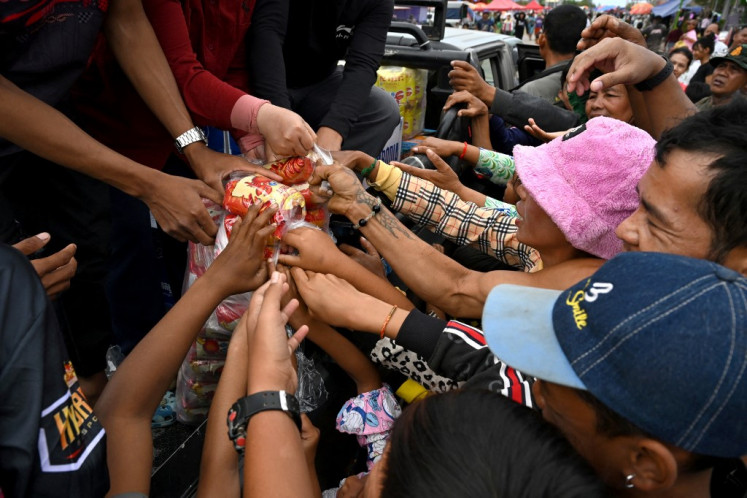Popular Reads
Top Results
Can't find what you're looking for?
View all search resultsPopular Reads
Top Results
Can't find what you're looking for?
View all search resultsMillennials learn the art of 'pantun'
In the Betawi culture of Jakarta, the pantun is still preserved in important events like weddings, which involves the exchange of pantun in a ceremony known as palang pintu (door barrier).
Change text size
Gift Premium Articles
to Anyone
W
hen it comes to the art of rhyme, Indonesia has the pantun (a traditional form of repetitive prose), which is believed to have been part of the country’s oral tradition for hundreds of years.
In the Betawi culture of Jakarta, the pantun is still preserved in important events like weddings, which involves the exchange of pantun in a ceremony known as palang pintu (door barrier).
Unfortunately, Jakarta’s rapid transformation into a modern, metropolitan capital has pushed some Betawi traditions to the point of vanishing, especially among the younger generations.
In an attempt to revive the art of pantun among Jakarta’s millennials, Mekar Pribadi, a foundation focused on culture and education, joined hands with the Education and Culture Ministry’s directorate of faith and traditions, and its directorate general of culture to stage a one-day pantun workshop on Monday at Taman Ismail Marzuki, Central Jakarta.
One of the participants, Nadia, 18, was appointed by her group to read out their pantun in front of 75 high school and university students. Instead of panicking, she was surprised at how much she enjoyed the task.
“It was fun. I could read my own modern version of a Betawi pantun, even though I was initially nervous to do it in front of an audience,” said Nadia, an international relations student at the Christian University of Indonesia (UKI).
During the workshop, participants were divided into small groups and challenged to create a pantun before reciting it.
Afterward, each was given a book to re-rewrite all the pantun that had been created at the event, which was also attended by illustrator Goes Noeg and legendary singer Titiek Puspa.
“Besides learning to write and read pantun, the students also learned to draw illustrations from Goes Noeg,” said Mekar Pribadi principal Oetari Noor Permadi. “We want the students to preserve traditional cultures, and by doing so, bridge the gap between older and younger generations.”
She emphasized the importance of Indonesia’s youths being able to identify and preserve their heritage.
“A culture can survive if its people — especially the younger generation — have a fondness for it. With this workshop, we hope to bring these youths closer to the Betawi pantun,” she added.
A traditional Betawi pantun is a poem that comprises a quatrain, or four lines of alternating rhymes. The first two lines are seemingly unconnected statements that are then made sense by the final two lines, which usually contain a message or lesson.
“Compared to traditional pantun from other parts of Indonesia, the Betawipantun uses the distinct Jakarta dialect,” said Betawi culture observer Heryus Saputro Samhudi.
“One example can be found in the use of the word ngapa [why], instead of formal Indonesian mengapa.”
Pantun can be categorized into pantun anak for children, pantun cinta to declare one’s love, the customary pantun adat, the religious pantun agama, pantun nasihat to offer advice and the humorous pantun jenaka.
One pantun adat reads:
Burung jawi burung puter (A Jawi bird is a bird that twirls)
Anak ayam disamber elang (A chick is eaten by an eagle)
Anak Betawi kudu pinter (A Betawi child must be clever)
Biar kampungnya kagak ilang (So that he won’t lose his village)
The first two lines are disconnected statements, but lines three and four warn Betawi children not to forget their heritage.
The message reflects the current situation of the Betawi people, who have become a minority in the capital due to the continuous inflow of migrants from other parts of the country. (sfr)











